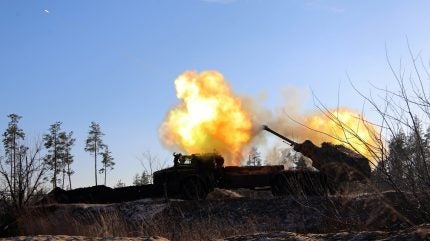
Recent developments in the Ukraine-Russia war point to the disturbing possibility that it is nearing a new escalatory phase, as allies of the two sides are further drawn into the consequences for their support.
A series of distinctive, yet connected, events in the Ukraine war point towards the potential for a further ratcheting up of tensions and the real prospect that third-party state forces could become embroiled in combat operations following reports that North Korean forces could join their Russian ally in Ukraine.

Discover B2B Marketing That Performs
Combine business intelligence and editorial excellence to reach engaged professionals across 36 leading media platforms.
Coupled with new US sanctions on Chinese industry amid claims that China’s is building and providing Russia with long-range attack drones, and the prospect of a European state-on-state war heading regional could have moved a step closer.
Are North Korea troops preparing to enter Ukraine-Russia war?
Recent reports by the BBC and other outlets on the prospect that North Korean nationals could make an entry into the Ukraine-Russia war indicate a potential serious military escalation, which up to now had seen Pyongyang restricting its support d to the provision of artillery ammunition and other equipment.
It is thought that between 2,000-12,000 North Korean nationals could be readied for operations in either eastern Ukraine or Russia’s Kursk region. Any use of North Koreans in the Kursk region would likely be attributed to the June signing between Moscow and Pyongyang of a mutual security pact, where the two countries pledged to come to each other’s aid should they be attacked.
However, the difficulties in integrating North Korean forces into Russian military structures are likely to be profound, ranging from differing weapons systems, command and control, and even the basics such as language.

US Tariffs are shifting - will you react or anticipate?
Don’t let policy changes catch you off guard. Stay proactive with real-time data and expert analysis.
By GlobalDataIt is not clear whether any North Korean troop contribution would be in the form of frontline troops or engineers and other specialists for use in further behind the lines.
US sanctions China for building Russian attack drones
Meanwhile, on 17 October the US State Department announced new sanctions on three entities and one individual involved in the development and production of Russia’s Garpiya series long-range attack UAVs.
The platform, designed and produced in China in collaboration with Russian defence companies, has been used to destroy critical infrastructure and has resulted in mass casualties, the State Department said.
“These sanctions targets were involved in the development and production of military equipment for a US-sanctioned Russian defence firm for use by the Russian military in Ukraine,” explained Matthew Miller, State Department spokesperson.
While the US has previously imposed sanctions on Chinese entities providing what the State Department described as “critical inputs to Russia’s military-industrial base, the latest set represent the first such sanctions issued to China’s defence base directly developing and producing complete weapons systems in partnership with Russia.
Ukraine has lost 30% of captured Kursk salient
Winter cannot come soon enough for Ukraine as it continues to defend against Russian attacks across the frontline, with the assessment that Ukrainian forces have lost around one-third of the territory it seized in August’s incursion in Russia’s Kursk region.
The maintenance of Ukrainian operations in Russian territory was set as a key condition in Ukrainian President Volodymyr Zelenskyy’s newly revealed victory plan, likely as a bargaining chip to limit the amount of territory that Ukraine would have to cede in any peace negotiations.
Following the unexpected incursion into Russia, Ukrainian forces have been engaged in constant combat as Moscow looks to retake the territory. It is understood that Russia is currently utilising VDV airborne troops in the Kursk region, with Ukraine’s defence hampered by the lack of fixed defensive infrastructure seen in the frontlines inside Ukraine itself.
Western officials have spoken of the slow degradation of the amount of land Ukraine seized in the Kursk region, amid daily Russian attacks.
Analysis indicates that Ukraine has lost up to 300km² of the 900km² it seized in the initial incursion into Russia, as it contends against hundreds of glide munition attacks.
Operations in the Kursk region are responsible for around 50% of Russia’s glide bomb attack on Ukrainian forces across the entire frontline, which totalled around 1,500 in September, potentially indicative of the importance that its recapture to Russian President Vladimir Putin.
Conditions on the ground inside frontline areas of Ukraine and Russia remain above freezing during nighttime, with a resultant wet or sub-zero winter period having significantly differing effect on the battlefield.
Russia has been on the offensive for much of 2024, capturing a series of strategically located towns in the east of Ukraine.





